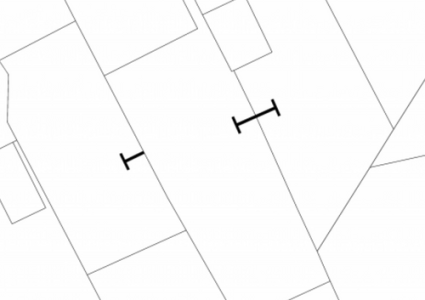|
Boundary disputes
A major consideration with boundary disputes is that even once settled, it’s highly unlikely there will be a return to good neighbourly relations. That is, until one party moves away. But therein lies another problem. When you come to sell your property, you must disclose the boundary dispute to a potential purchaser. And that even applies following the resolution of the dispute. However, explaining a settled dispute is much easier than putting a positive spin on an ongoing legal battle!
But should you ‘forget’ to mention the dispute, it will inevitably come to light, probably very soon after completion. You then run a significant risk of your purchaser bringing a claim for compensation against you.
Contents
- Property boundaries
- Land Registry boundary determination
- Inward-facing T boundary
- Boundary disputes examples
- Boundary Disputes Protocol
- Is there a time limit on boundary disputes?
- Boundary dispute surveyors
- Boundary disputes mediation
- 7 year boundary rule
- Boundary dispute solicitors
Property boundaries
Disputes over property boundaries often arise because the exact position of the boundary line is unclear. Understandably, you may believe a boundary feature at the extent of your property delineates the boundary. That might be a wall, a fence, or an organic boundary such as a hedge or a tree line. But it’s rarely that straightforward.
See also: Boundary fence rules
Land Registry boundary determination
With a questionable boundary line, an understandable first reaction is to reach for your Land Registry title plan. But other than the rare exception of a “determined boundary” following a Land Registry boundary determination, title plans do not establish the legal boundary of a property with any degree of precision. Indeed, there is no legal or procedural requirement to have exact boundaries recorded anywhere.
Based on Ordnance Survey maps, Land Registry plans show only “general boundaries”. Exact boundary lines are left undetermined. The scale of the plan is also problematic. What appears the thinnest of lines on the plan probably equates to around a metre in width when scaled up on the ground. For all practical purposes then, Land Registry plans are pretty useless in determining your exact boundary line.
Inward-facing T boundary
 A couple of myths often adopted as ‘evidence’ in boundary disputes are:
A couple of myths often adopted as ‘evidence’ in boundary disputes are:
- You always own the left-hand fence when facing your house.
- If a T-mark on the title plan is inward-facing to your property, you own the boundary feature.
Although both statements are wrong, an inward-facing T-mark usually indicates responsibility for repairing that boundary, although it’s crucial to check the wording of the deed in each case for the meaning given to the T-mark. However, the Court of Appeal has held that the T-mark does not also mean (or indicate) that you own that boundary feature – wall, fence etc.
Boundary disputes examples
A typical question is whether the boundary line follows the centre point of a structure or hedge. Was it built or planted on one side of the boundary, or does it straddle it? A cautious predecessor may have erected a fence on what they considered to be their side. A reckless or enterprising one on their neighbour’s side! What if there is no tangible barrier at all between the properties? Or what if there are multiple features together, such as a fence in front of a hedge? Similarly, what if your neighbour has removed the boundary fence altogether?
To further muddy the waters, boundaries can and do evolve over time. If your house is 100 years old, the current boundaries are unlikely to be precisely the same as they were a century ago.
Many boundary disputes involve a claim for adverse possession, a complex and highly specialist area. See:
Boundary Disputes Protocol
However unattractive the prospect, boundary disputes with neighbours sometimes mean you have little alternative but to challenge your neighbour’s case over the position of a boundary.
The Civil Procure Rules (CPR) provide several pre-action protocols for parties to follow in different types of dispute. Unfortunately, a formal protocol for boundary disputes is not yet in place. But in 2018, at the request of the Ministry of Justice, the Civil Justice Council (CJC) issued a guidance note on boundary disputes “to assist parties to achieve the resolution of a boundary dispute quickly and at limited cost.” The focus of these notes is to encourage “those with a dispute to view court proceedings as a last resort”.
The CJC received significant input from the Royal Institution of Chartered Surveyors and the Property Litigation Association. These two organisations have produced their own protocol, referenced in the CJC guidance notes. This voluntary protocol has no strict legal status. However, parties should nevertheless treat it as providing a ‘best practice’ guide to the early resolution of boundary disputes. After all, it seems to have received the tacit approval of the CJC. And if court proceedings are subsequently necessary, the court will likely look favourably on compliance with it.
Is there a time limit on boundary disputes?
Mentioning time limits in a boundary dispute likely means that one neighbour has raised the issue of adverse possession.
Boundary dispute surveyor
Often, the key to settling the issue of a questionable boundary at an early stage is obtaining a high-quality boundary survey. However, it’s crucial to instruct an experienced boundary dispute surveyor. Unfortunately, it’s not unusual to find a party seeking to rely upon a poor-quality survey that does not accurately reflect the position on the ground. Also, it’s not unusual to find a surveyor has exacerbated a situation by failing to act in accordance with either their professional code of conduct or their duty to the court as an expert witness. This can be avoided by using an experienced boundary dispute surveyor.
A plan should be detailed and produced in compliance with the CPR by a specialist chartered land surveyor. It should be made available in electronic form for easy reproduction and to enable detailed and accurate measurements. Your boundary dispute solicitor will be able to recommend a suitable boundary dispute surveyor.
Boundary disputes mediation
Should your boundary dispute mean that litigation becomes necessary, the county court will expect both parties to have at least considered other methods of resolving their dispute before bringing it before the court. The most common form of alternative dispute resolution is mediation.
 A mediator is a neutral third party. They receive training in dealing with difficult discussions between two or more parties, with a view to helping them negotiate a settlement. If a settlement proves possible, the mediator will encourage the parties to put the agreement in writing and make it binding.
A mediator is a neutral third party. They receive training in dealing with difficult discussions between two or more parties, with a view to helping them negotiate a settlement. If a settlement proves possible, the mediator will encourage the parties to put the agreement in writing and make it binding.
Each party can either attend the mediation on their own or with a solicitor or other adviser. Mediation focuses on practical rather than legal solutions. Therefore, the mediation often occurs at or close to the premises. This enables the mediator and the parties to view possible solutions in context. Mediation does not compromise a party’s position should settlement not be possible and the matter proceeds to court.
A major consideration is that mediation over a boundary dispute is inevitably significantly less expensive than taking the matter to court.
7 year boundary rule
There is a widespread but mistaken belief in a 7 year boundary rule. The thinking appears to be that possessing a piece of land for 7 years entitles you to adverse possession. It doesn’t. Broadly, the periods involved for adverse possession are either 10 or 12 years. For more information, see Adverse Possession. A separate period of 20 years applies to claims to acquire easements by prescription.
Boundary dispute solicitor
When faced with a boundary dispute, in every case, it’s always important to find out where you stand legally. Taking advice early on can save considerable expense.
The starting point is usually an analysis of the deeds, particularly the ‘operating conveyance’, which should indicate where the legal boundary was intended to be at the time of that conveyance.
Next, reviewing whether the legal position might have changed over time is necessary. For example, one neighbour may have erected a fence where the position of the boundary is vague or open to interpretation. After 10 or 12 years, this new feature could come to mark the boundary, even if it did not when first installed.
Another factor to consider is whether, in the past, you or your predecessor at the property reached an informal agreement about the boundary. Even though such an agreement was not documented and occurred before you owned the property, it could still be binding.
Boundary disputes can become complex and costly. However, our boundary dispute solicitors will provide you with realistic and strategic advice and representation that, wherever possible, is aimed at achieving a swift and cost-effective solution.

 “In my experience, few things stir emotions between neighbours quite as much as a boundary incursion.
“In my experience, few things stir emotions between neighbours quite as much as a boundary incursion.
